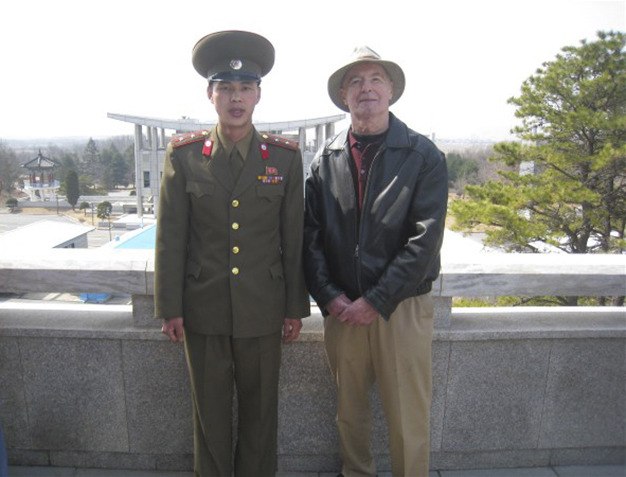One month after North Korea’s third nuclear test, Bob Lewis boarded a plane to Pyongyang.
Lewis, 81, a retired dentist, has visited many places — Vietnam, Mexico, the Canary Islands, the Mediterranean, and even Iran and Cuba. He has traveled extensively in Central and South America. When he found out that a small number of American tourists are allowed into North Korea every year, he decided that it would be an interesting place to visit at the end of March. His wife, Anne, did not concur. She went to New Orleans instead.
In Beijing, Lewis joined Koryo Tours. Forty-five people were divided into three tour groups.
Lewis was the eldest in his group of 15 tourists who came from the Netherlands, Australia, New Zealand, Germany, Italy and Russia. They were people who “seemed more adventuresome,” Lewis said. Most were men, and the average age was 40. Other Americans hailed from Chicago and New Jersey.
North Korean propaganda began on the 90-minute flight from Beijing into Pyongyang, when pictures were shown of the Korean War — from North Korea’s perspective.
The group’s seven-day itinerary included the Pyongyang Metro, 300 feet underground; a mountain resort, Mt. Myohyang; Kaesong and the demilitarized zone, or “DMZ.”
At the border, Lewis observed that everyone was always facing north, including the South Koreans, who were stationed 100 feet away from North Korean soldiers. He saw no barbed wire, but his group was warned about where they could not cross or go. Anyone who went down into a certain section could be shot.
“What we saw wasn’t the real North Korea. We saw parts of it,” Lewis said. “We saw very little of the poverty, the problems they have, how screwed up that government is, how poorly that country is run.”
They did see workers in fields, planting crops and using oxen to pull old-fashioned, single-bladed plows.
“They seemed to be extremely short of mechanized machines,” Lewis said. Four or five workers overseen by a person in uniform would shovel dirt onto a pallet, pick up the pallet, and walk it over to be dumped, then repeat the process.
“North Korea is totalitarian with an elaborate cult of personality around the Kim family and one of the lowest ranking human rights records of any country. In 2011, North Korea had the lowest Democracy Index of any nation on earth. It reminded me of George Orwell’s book, ‘1984,’” Lewis stated in a presentation at Aljoya.
North Korea imprisons an estimated 200,000 people in political prison camps. Crime is not prevalent, as anyone even caught stealing goes to prison, Lewis said. Half of the country is starving. North Korea has the most cases of tuberculosis in the world, he said, due to hunger and starvation.
While comfortable accommodations were lacking, Lewis found the food to be good. Hot water was a rarity, and occasional power outages occurred. Lewis slept on a mat on the floor — the way the North Koreans live.
Pyongyang boasts the tallest hotel in the world, with 110 floors; but it is not open. Built in 1988, the hotel was never finished. It is merely for show.
Roads — mostly large boulevards — have traffic directors, but no traffic except some bicycles and military vehicles. People walk or travel by bus.
Photos of the three leaders of the Kim regime are not allowed to be discarded — not even newspapers with their pictures can be thrown away. Pictures taken of their statues must show the whole statue and not cut off their feet or hands.
TV, radio and Internet are all internal with no access to the outside world.
Nothing is for sale except in tourist shops, which offer books about communism and the Kim family, or dolls. Lewis saw no unique crafts and did not know where people get their food. Foreigners can only use euros, dollars or yen, and must always be with a guide. Guides who “lose” tourists can be fired, Lewis said.
Lewis attended a soccer game on a Wednesday morning in a stadium with the capacity for more than 50,000 people. Less than 100 people attended the game, which was some sort of playoff game between an army team and a light industry team. The army lost.
Lewis’ guide asked him, “Are the young people in the U.S. still rioting or causing demonstrations about our situation here?”
Lewis told him, no. “I had the feeling he didn’t believe me,” he said.
While Lewis did not feel any danger there, he would not go again, he said.
“It is a very novel place to be,” he said. “You sit around thinking, is this really happening?”



